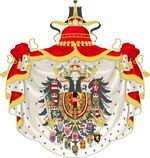Werfareich
The Imperial Commonwealth of Werfareich Kaiserlicher Staatenbund Werfareich | |
|---|---|
Flag
| |
Motto: "Unity, Independence, Nation"
("Einheit, Unabhängigkeit, Nation") | |
| Capital and largest city | Stolzenburg |
| Official languages | Werfish |
| Recognised national languages | Werfish, Levurian |
| Ethnic groups (2020) | Werfians (79.9%) Levurians (17.6%) Mereans (1.7%) others (0.8%) |
| Religion | Romehnen Church |
| Demonym(s) | Werfians |
| Government | Federal parliamentary constitutional dual monarchy |
• Monarch | Stephanie I von Schwarzenbach |
• Reich Chancellor | Adam Georg von Schinkel |
• Bundesrat President | Fritz Steinhäuser |
• Bürgerrat President | Friedrich Holz |
| Legislature | Reichstag |
| Bundesrat | |
| Bürgerrat | |
| History | |
| 1200 BSC | |
• Formation of the feudal principality of Hesselberg | 486 BSC |
• Streifen Agreement. Establishment of the Imperial Commonwealth of Werfareich | 207 BSC |
• Water (%) | 1.8% |
| Gini (195) | 36.0 medium |
| HDI (195) | 0.992 very high |
| Currency | Reichsmark (ℳ) (WRM) |
| Time zone | UTC0:00 (UTC) |
| Date format | yyyy-mmm-dd |
| Driving side | right |
| Calling code | +366 |
| Internet TLD | .wr |
Werfareich [wɪəfaˈraɪh], officially the Imperial Commonwealth of Werfareich (Werfish: Kaiserlicher Staatenbund Werfareich [kai`zalihe ∫ta:tnbunt wɪəfaˈraɪh]) is a sovereign state located in three parts of Ersetum: the western part of the country in Eastern Kyrazanium (Werfish: Östliches Kyrazanium), the southern one in Manchakk (Werfish: Manntschachen), and the northern one in Kaurikia (Werfish: Kaurikien). It is bound to the south by Morea, also, in the south, washed by the Stateira Sea (Werfish: Ztateyrisches Meer). Stolzenburg is the country's capital and the most populous city is the main cultural and economic centre of Werfareich; other major cities and urban areas include Branitz, Kleinzschachwitz, Lauterberg, Rabenholz, Lammersdorfen, Pfalzel and Ganzig.
The monetary unit is the Reichsmark (ℳ). The state language is Werfish.
Etymology
The word "Werfaraich", according to some etymologists, comes from the ancient Werfish, and means "Throwers". According to the classical theory, made on the basis of archaeological finds, the indigenous Wanderman tribe "Vendeerman" lived in the Leupolz region. The first mention of the Wanderman tribes dates back to the middle of the third century AD. It is mentioned in the chronicles of the Rumanian State, which describes the nomadic tribes of Wandermans, Hestergottmanns and Norts who arrived from the northeast and settled in the Smaragdtal valley. The word "Aruncatori", used by the Rumanian State for a general designation of all the tribes of the Smaragdtal valley, quickly caught on at the diplomatic level, as the Rumanian State was the cultural and technological hegemon in the region. Many states called Werfaraich in their own way, depending on linguistic and cultural norms.
According to another, less common, version, the word Werfaraich is a misspelled word "wafer" - a traditional dish of the Werfaraich cuisine. Werfish is the word "Oblate", in the Weccan language it is called "wafer". It is believed that the first Weccandian merchants who brought a previously unknown product to their homeland gave it the name "wafer". From this theory, it turns out that Werfaraich is the land of the wafer. But this theory was recognized as untenable due to the fact that no direct evidence in favor of this theory was found.
In relation to the inhabitants of Werfaraich, the term Werfians is commonly used.
History
Geografy
Topography and geology
Climate
Biodiversity and environment
Demographics
Religion
Ethnicity
Language
Education
Health
Largest Cities
Largest cities or towns in Werfareich
State Bureau of Statistics (SBS), 196 estimate | |||||||||
|---|---|---|---|---|---|---|---|---|---|
| Rank | State | Pop. | Rank | State | Pop. | ||||
 Stolzenburg  Branitz |
1 | Stolzenburg | Aalen | 2,413,802 | 11 | Kolochau | Ellerbrok | 267,014 |  Kleinzschachwitz  Lauterberg |
| 2 | Branitz | Aalen | 1,654,331 | 12 | Tonndorf | Leupolz | 261,310 | ||
| 3 | Kleinzschachwitz | Ritzerau | 1,022,854 | 13 | Kraschwitz | Leupolz | 211,700 | ||
| 4 | Lauterberg | Strodehne | 825,911 | 14 | Klaffenbach | Aumund | 198,209 | ||
| 5 | Rabenholz | Leupolz | 774,140 | 15 | Datteln | Ludwigsruhe | 187,885 | ||
| 6 | Lammersdorfen | Ludwigsruhe | 599,108 | 16 | Borntin | Laupin | 184,063 | ||
| 7 | Pfalzel | Ludwigsruhe | 500,392 | 17 | Lynow | Loitze-Haarland | 172,496 | ||
| 8 | Ganzig | Laupin | 416,026 | 18 | Eckstedt | Ritzerau | 168,584 | ||
| 9 | Kavelstorf | Strodehne | 392,641 | 19 | Curau | Ludwigsruhe | 156,005 | ||
| 10 | Kitzburg | Strodehne | 306,857 | 20 | Wertlau | Vierst | 155,713 | ||
